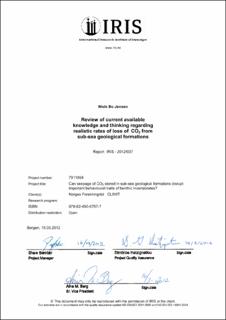Review of current available knowledge and thinking regarding realistic rates of loss of CO2 from sub-sea geological formations
| dc.contributor.author | Jensen, Nils Bo | |
| dc.date.accessioned | 2019-12-05T07:18:24Z | |
| dc.date.available | 2019-12-05T07:18:24Z | |
| dc.date.issued | 2012 | |
| dc.identifier.isbn | 978-82-490-0767-7 | |
| dc.identifier.uri | http://hdl.handle.net/11250/2631830 | |
| dc.description.abstract | This report presents a review of current available knowledge and thinking regarding realistic rates of loss of carbon dioxide from sub-sea geological formations. Leakage rates obtained from natural environments are the most common source of data to be used as analogues to industrial CO2 sequestration. Most data are available from the terrestrial environment, however, actual rates and total amounts of released carbon dioxide are often uncertain. The same is the case for the marine environment but a recent discovery of a carbon dioxide seep at Salt Dome Juist in the southern North Sea has revealed interesting data from observations and modelling. The highest leakage rate scenario can probably be expected from pipelines or well head failures. | nb_NO |
| dc.description.sponsorship | Norges Forskningråd | nb_NO |
| dc.language.iso | eng | nb_NO |
| dc.publisher | IRIS Miljø | nb_NO |
| dc.title | Review of current available knowledge and thinking regarding realistic rates of loss of CO2 from sub-sea geological formations | nb_NO |
| dc.type | Research report | nb_NO |
| dc.source.issue | Report IRIS - 2012/037 | nb_NO |
| dc.source.pagenumber | 18 | nb_NO |
| dc.subject.nsi | Naturvitenskap | nb_NO |
